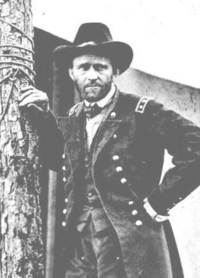Grant, Ulysses S.
 U.S. Grant’s life story cannot be fairly treated here. Space permits an abbreviated mention of his many Missouri ties. They begin at West Point in 1842, when Fred Dent of St. Louis became his roommate.
U.S. Grant’s life story cannot be fairly treated here. Space permits an abbreviated mention of his many Missouri ties. They begin at West Point in 1842, when Fred Dent of St. Louis became his roommate.
After West Point, Grant’s first post was Jefferson Barracks near St. Louis; He soon was introduced to Fred’s sister, 18 year old Julia Dent. After a long engagement, they married in 1848. When his first stint in the regular Army ended, Grant lived on the Dent estate, farming two parcels, for most of his St. Louis years, 1854-1860. The Dent home, “Whitehaven,” owned by Grant and his wife for a time during his presidency, is the only home he ever owned. Restored in the 1990’s, it is now the Ulysses Grant National Historic Site.
Grant, in the wake of business failures, moved to Galena, Illinois, in 1860. In 1861 he was back in action, and the action was in Missouri. Colonel Grant, commanding the 21st Illinois, entered northeast Missouri in the first days of July, 1861. His mission: Defend the Hannibal & St. Joseph Railroad, which was then the western-most link in the nation’s rail network. His activities until August were concentrated on Missouri’s railroads, as he and the 21st Illinois moved south, stopping at Mexico, Jefferson City, and, finally, at the terminal point of the Iron Mountain Railroad, at Ironton, 80 miles south of St. Louis. There, camped by a spring which still flows, Grant received his commission as a brigadier general, and command of union forces in southeast Missouri. Grant faced regular Confederate troops at Greenville, and the wily “Swamp Fox”, M. Jeff Thompson, who was everywhere.
The Battle of Belmont, November 7, 1861, was Grant’s first, and had as its objective the Confederate gibralter at Columbus, Kentucky. His first effort failed, but in his fashion he followed with an “end-around.” Columbus was abandoned when Grant captured Fort Donelson, east in the Tennessee-Cumberland valley. The rest, at they say, is history.

